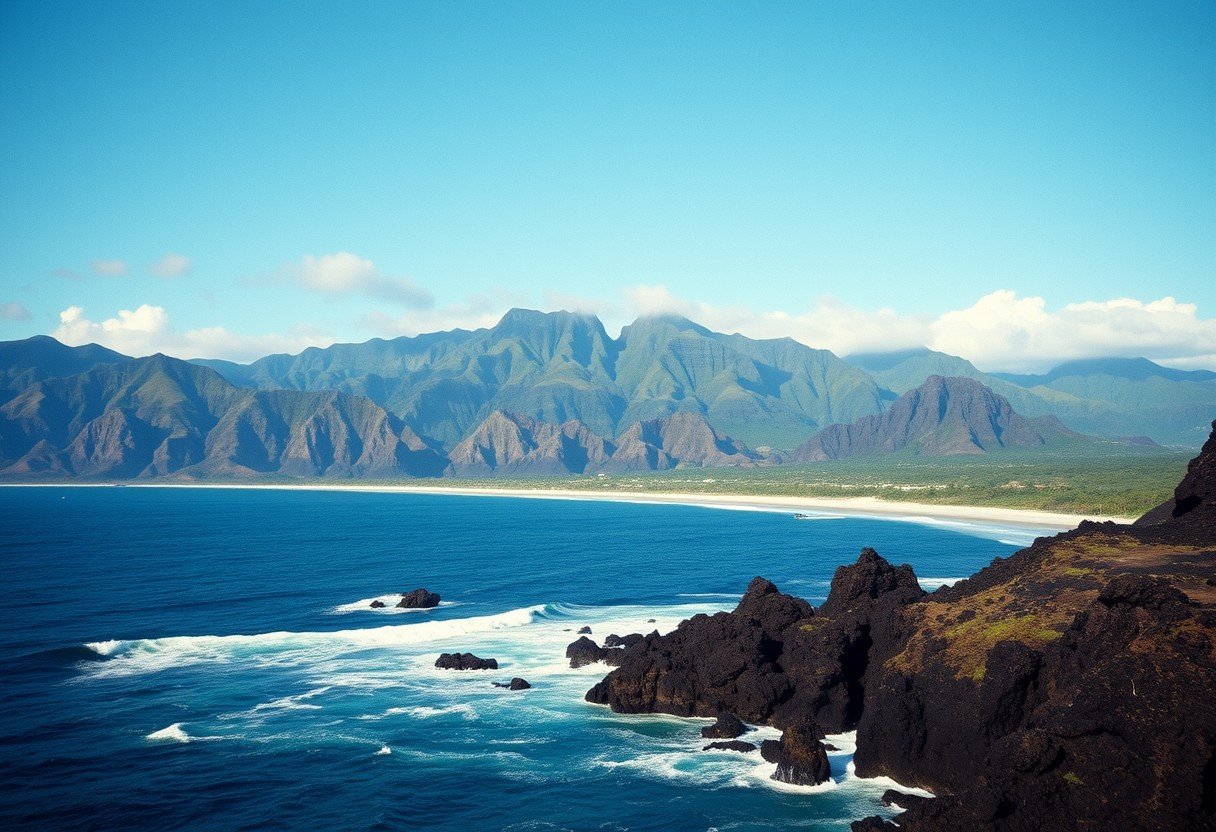You might be surprised to learn that the remote island chains of Hawaii, Tahiti, and Tristan da Cunha have a deep connection. Despite being thousands of miles apart in different oceans, they all share a fiery beginning. This article explores their common volcanic origins, unique cultures shaped by isolation, and the modern challenges they face, revealing the fascinating links between these distant paradises.
A Shared Volcanic Birth: The Hotspot Connection
The story of these islands begins deep within the Earth. All three chains were formed by a process called hotspot volcanism. Imagine a stationary blowtorch (the hotspot) under a moving conveyor belt (a tectonic plate). As the plate drifts over the fixed plume of hot magma, volcanoes erupt, creating islands.
This process explains the linear arrangement of islands you see in places like Hawaii. The oldest islands are furthest from the hotspot, having moved away over millions of years, while the youngest, most active islands sit directly on top of it. This geological conveyor belt is responsible for creating these stunning and isolated landmasses from the ocean floor up.
While Hawaii is the classic example of a hotspot chain, Tahiti and Tristan da Cunha also owe their existence to similar geological forces. Their formation is tied to plate tectonics and the movement of the Earth’s crust, which creates opportunities for magma to punch through and build islands over geological time.
Life in Isolation: Unique Plants and Animals
Extreme isolation has turned these islands into natural laboratories for evolution. Separated from continents by vast oceans, life here developed in unique ways, leading to an incredible number of endemic species, meaning they are found nowhere else on Earth.
Each island chain boasts its own biological treasures. Hawaii is famous for its silversword plants that grow on volcanic slopes and the Hawaiian goose (Nene). Tahiti is covered in lush vegetation, including its iconic coconut palms. Tristan da Cunha, one of the most remote inhabited places, is a critical habitat for the endangered Tristan albatross and unique flora adapted to its harsh, windy climate.
Animals and plants on these islands show amazing adaptations. For example, some Hawaiian honeycreeper birds evolved specialized beaks perfectly shaped to drink nectar from specific native flowers. In Tristan da Cunha, many species have adapted to the strong winds and unpredictable weather, often through smaller body sizes or unique nesting behaviors that offer protection from the elements.
Cultural Tapestry Woven by the Sea
Geography doesn’t just shape landscapes; it shapes people. The indigenous cultures of Hawaii, Tahiti, and Tristan da Cunha are deeply connected to their environments. Over centuries, vibrant and distinct traditions in art, language, and social structure evolved in isolation.
In Hawaii, native traditions like the hula dance and the art of lei-making are vital parts of spiritual and social life. Tahitians celebrate their heritage through powerful dances and oral storytelling passed down through generations. The people of Tristan da Cunha, with a heritage tracing back to British settlers, have a unique culture centered on community cooperation, fishing, and farming, complete with their own dialect.
These rich cultural traditions continue to influence modern society on the islands. They are not just historical artifacts but are living, breathing parts of the community, often showcased in tourism, contemporary art, and daily life, helping to preserve their unique identities in a globalized world.
Island Economies: Tourism and Tradition
The economies of these remote islands are a delicate mix of modern industry and traditional practices. Due to their natural beauty, tourism is a major economic driver for all three, though on vastly different scales. This reliance creates both opportunities and vulnerabilities.
Several key factors shape their economic landscape:
- Tourism as a Revenue Source: Hawaii and Tahiti attract millions of visitors, creating jobs in hospitality and entertainment. Tristan da Cunha’s tourism is extremely limited due to its remoteness, making each visitor’s impact significant.
- Traditional Industries: Fishing and agriculture remain important, especially in Tahiti and Tristan da Cunha, providing food and a connection to cultural heritage.
- Dependency on Imports: Their isolation makes them heavily dependent on imported goods, from food to fuel, which can be expensive and unreliable.
Sustainable development is crucial for their future. This means balancing economic needs with environmental protection. Initiatives often focus on renewable energy, waste reduction, and preserving the marine ecosystems that attract visitors and support local communities.
Key Differences Between the Island Chains
While they share a volcanic origin, these three archipelagos are remarkably different. Their unique locations, histories, and levels of development have created distinct identities. Their accessibility, cultural influences, and modern lifestyles vary significantly.
The table below highlights some of their key distinctions, offering a quick comparison.
| Aspects | Details |
|---|---|
| Geological Formation | Hawaii and Tahiti are classic hotspot volcanic islands. Tristan da Cunha is the peak of a massive volcano rising from the Mid-Atlantic Ridge. |
| Culture | Hawaii has a rich Polynesian culture with significant American and Asian influence. Tahiti’s culture is Polynesian with a strong French influence. Tristan da Cunha has a unique culture derived from its British lineage. |
| Accessibility | Hawaii is a major global travel hub and is very accessible. Tahiti is a popular but less frequented tourist destination. Tristan da Cunha is one of the most remote inhabited places on Earth, accessible only by a multi-day boat journey. |
Modern Challenges for Remote Paradises
Living in paradise comes with a unique set of challenges. These islands’ isolation and delicate ecosystems make them particularly vulnerable to modern pressures. They face significant threats that could alter their environments and way of life forever.
Climate change is arguably the most significant threat. Rising sea levels, increased storm intensity, and ocean acidification directly impact island communities and ecosystems. Saltwater can contaminate freshwater sources, while stronger storms can cause severe erosion and damage habitats. These changes pose a direct risk to the infrastructure, agriculture, and natural beauty of the islands.
In response, conservation efforts are a top priority. Local communities and organizations are working to protect native species, remove invasive plants and animals, restore damaged habitats like coral reefs, and promote sustainable tourism. These initiatives are vital to ensuring these unique island paradises remain vibrant for future generations.
Frequently Asked Questions
What geological process created Hawaii, Tahiti, and Tristan da Cunha?
All three island chains were formed by hotspot volcanism. This occurs when a tectonic plate moves over a stationary plume of hot magma from the Earth’s mantle, creating a chain of volcanic islands over millions of years.
Are these island chains located near each other?
No, they are geographically very isolated from one another. Hawaii is in the central Pacific Ocean, Tahiti is in the South Pacific, and Tristan da Cunha is in the South Atlantic Ocean, separated by thousands of miles of water.
Do these islands have similar climates?
They all share generally subtropical or tropical climates due to their oceanic locations. However, there are differences: Hawaii has many microclimates, Tahiti has distinct wet and dry seasons, and Tristan da Cunha has a cooler, stormier maritime climate because of its more southerly location.
How has isolation affected the culture of these islands?
Isolation has allowed each island chain to develop a unique cultural identity. Hawaiian and Tahitian cultures are rooted in Polynesian traditions, while Tristan da Cunha’s culture is primarily influenced by its British settlers, leading to distinct languages, customs, and community structures.
What is the biggest threat facing these islands today?
Climate change is a major threat, causing rising sea levels, more intense storms, and ocean acidification. These effects endanger freshwater supplies, cause coastal erosion, and damage the fragile ecosystems that both wildlife and the island economies depend on.









Leave a Comment